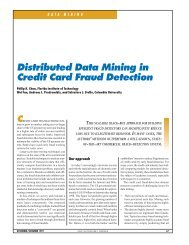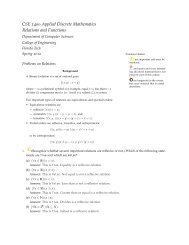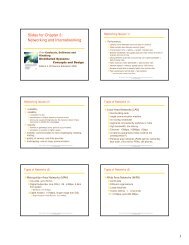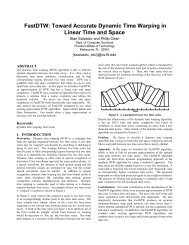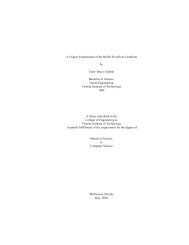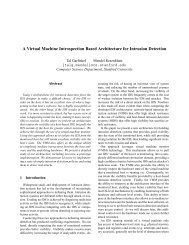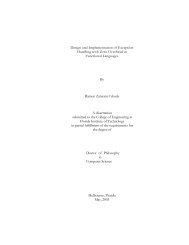Social Choice Theory and Recommender Systems ... - CiteSeerX
Social Choice Theory and Recommender Systems ... - CiteSeerX
Social Choice Theory and Recommender Systems ... - CiteSeerX
Create successful ePaper yourself
Turn your PDF publications into a flip-book with our unique Google optimized e-Paper software.
properties that <strong>Social</strong> <strong>Choice</strong> theorists have found to becompelling are also arguably desirable in the context ofCF. In particular, universal domain (UNIV) is universallyaccepted. Unanimity (UNAM) is compelling <strong>and</strong> common.Most of the other properties have been advocated (at leastimplicitly) elsewhere in the literature. Similarity-basedmethods with only positive reinforcement obey UNAM,including vector similarity <strong>and</strong> mean squared difference.Most similarity-based techniques obey independence ofirrelevant alternatives (IIA) <strong>and</strong> translation invariance (TI).Freund et al. [1998] <strong>and</strong> Cohen et al. [1999] make the casefor scale invariance (SI).We have identified constraints that a CF designer mustlive with, if their algorithms are to satisfy sets of theseconditions. Along with UNIV <strong>and</strong> UNAM, IIA <strong>and</strong> SIimply the nearest neighbor method, while IIA <strong>and</strong> TI implythe weighted average. A second derivation shows that, ifall users’ ratings are utilities, <strong>and</strong> if unanimity of equalityholds, then, once again, only the weighted average isavailable.Finally, we discussed implications of this analysis,highlighting the fundamental limitations of CF, <strong>and</strong>identifying a bridge from results <strong>and</strong> discussion in <strong>Social</strong><strong>Choice</strong> theory to work in CF. This avenue of opportunityincludes the implementation of weighted versions ofvoting mechanisms as potential new CF algorithms.AcknowledgmentsThanks to Jack Breese <strong>and</strong> to the anonymous reviewers forideas, insights, <strong>and</strong> pointers to relevant work.ReferencesKenneth J. Arrow. <strong>Social</strong> <strong>Choice</strong> <strong>and</strong> Individual Values.Yale University Press, second edition, 1963.Daniel Billsus <strong>and</strong> Michael J. Pazzani. Learningcollaborative information filters. In Proceedings of theFifteenth International Conference on Machine Learning,pages 46–54, July 1998.John S. Breese, David Heckerman <strong>and</strong> Carl Kadie.Empirical analysis of predictive algorithms forcollaborative filtering. In Proceedings of the FourteenthAnnual Conference on Uncertainty in ArtificialIntelligence, pages 43–52, July 1998.William W. Cohen, Robert E. Schapire, <strong>and</strong> Yoram Singer.Learning to order things. Journal of Artificial IntelligenceResearch, 10: 243–270, 1999.Jon Doyle <strong>and</strong> Michael P. Wellman. Impediments touniversal preference-based default theories. ArtificialIntelligence, 49: 97–128, 1991.Peter C. Fishburn. The <strong>Theory</strong> of <strong>Social</strong> <strong>Choice</strong>. PrincetonUniversity Press, Princeton, New Jersey, 1973.Peter C. Fishburn. Interprofile Conditions <strong>and</strong>Impossibility. Harwood Academic Publishers, New York,1987.Yoav Freund, Raj Iyer, Robert E. Schapire, <strong>and</strong> YoramSinger. An Efficient boosting algorithm for combiningpreferences. In Proceedings of the Fifteenth InternationalConference on Machine Learning, pages 170–178, 1998.David Goldberg, David Nichols, Brian M. Oki, <strong>and</strong>Douglas Terry. Using collaborative filtering to weave aninformation tapestry. Communications of the ACM, 35(12):61–70, December 1992.John C. Harsanyi. Cardinal welfare, individualistic ethics,<strong>and</strong> interpersonal comparisons of utility. Journal ofPolitical Economy, 63(4): 309–321, August 1955.Joseph A. Konstan, Bradley N. Miller, David Maltz,Jonathan L. Herlocker, Lee R. Gordon, <strong>and</strong> John Riedl.GroupLens: Applying collaborative filtering to Usenetnews. Communications of the ACM, 40(3): 77–87, 1997.Atsuyoshi Nakamura <strong>and</strong> Naoki Abe. Collaborativefiltering using weighted majority prediction algorithms. InProceedings of the Fifteenth International Conference onMachine Learning, pages 395–403, July 1998.Paul Resnick <strong>and</strong> Hal R. Varian. <strong>Recommender</strong> systems.Communications of the ACM, 40(3): 56–58, March 1997.Paul Resnick, Neophyts Iacovou, Mitesh Suchak, PeterBergstrom, <strong>and</strong> John Riedl. GroupLens: An Openarchitecture for collaborative filtering of netnews. InProceedings of the ACM Conference on ComputerSupported Cooperative Work, pages 175–186, 1994.K. W. S. Roberts. Interpersonal comparability <strong>and</strong> socialchoice theory. Review of Economic Studies, 47: 421–439,1980.Leonard J. Savage. The Foundations of Statistics. DoverPublications, New York, 1972.Amartya Sen. <strong>Social</strong> <strong>Choice</strong> theory. In H<strong>and</strong>book ofMathematical Economics, volume 3, Elsevier SciencePublishers, 1986.Upendra Shardan<strong>and</strong> <strong>and</strong> Pattie Maes. <strong>Social</strong> informationfiltering: Algorithms for automating “word of mouth.” InProceedings of Computer Human Interaction, pages 210–217, May 1995.John von Neumann <strong>and</strong> Oskar Morgenstern. <strong>Theory</strong> ofGames <strong>and</strong> Economic Behavior. Princeton UniversityPress, Princeton, New Jersey, 1953 (© 1944).



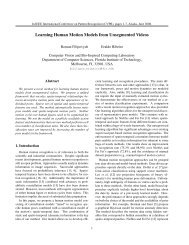
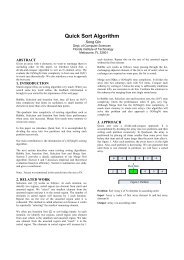
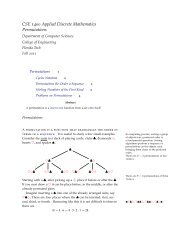
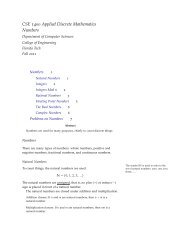
![{ public static void main (String[] args) { System.out.println (](https://img.yumpu.com/49719541/1/190x143/-public-static-void-main-string-args-systemoutprintln-hello-.jpg?quality=85)
